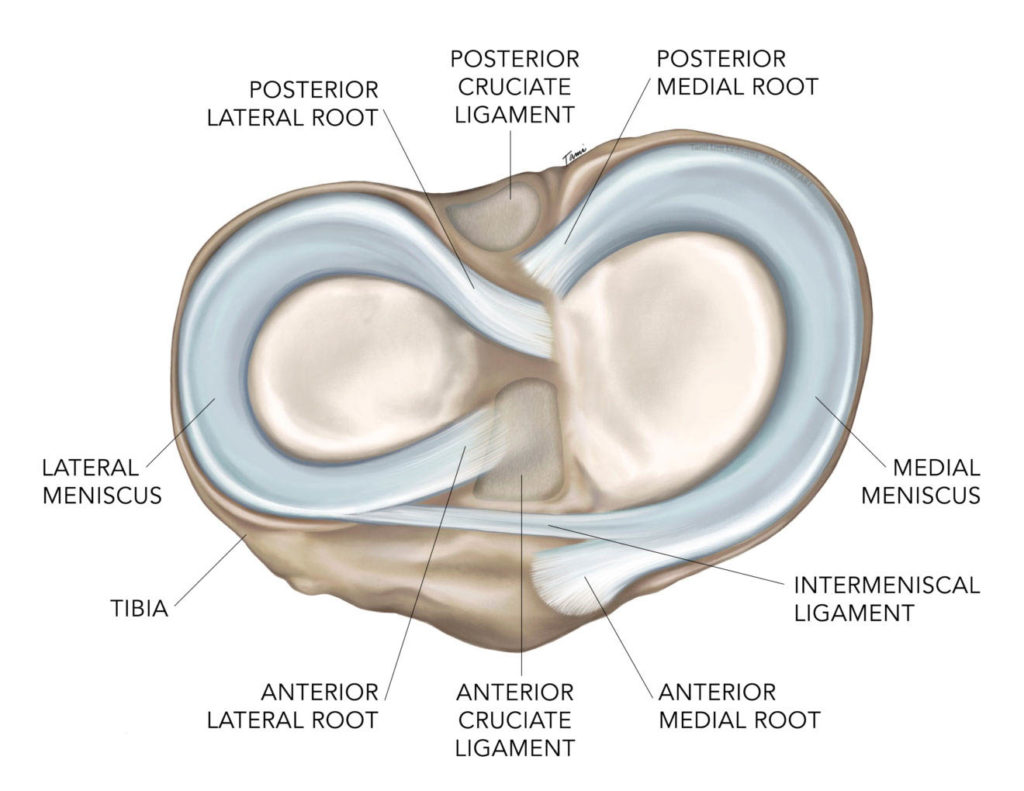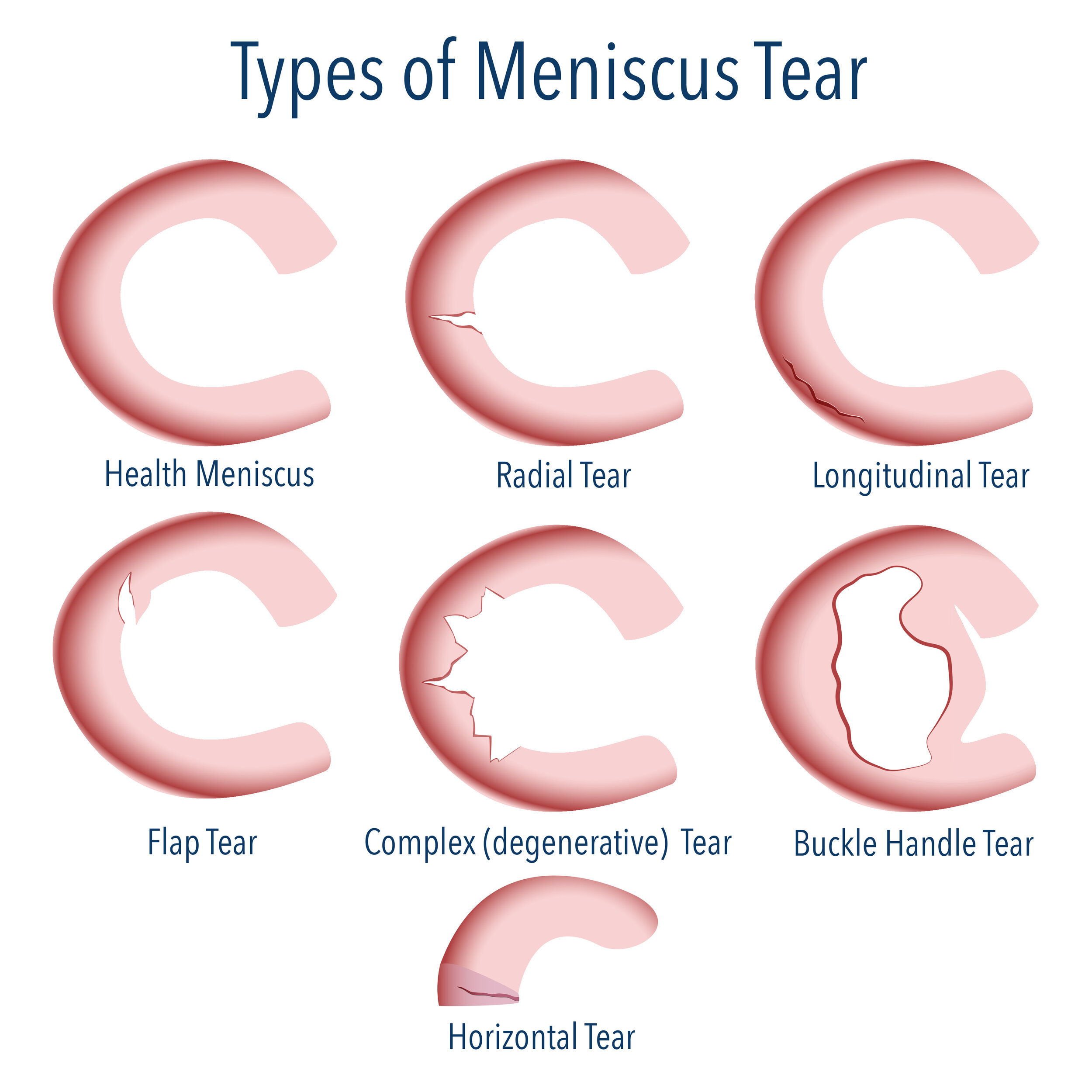Anatomy and Function of the Meniscus: Meniscus Tear

The meniscus is a C-shaped piece of cartilage that acts as a shock absorber and helps to stabilize the knee joint. It’s like a rubber gasket between your thigh bone and shin bone. There are two menisci in each knee, a medial meniscus on the inside of the knee and a lateral meniscus on the outside.
Location and Structure of the Meniscus, Meniscus tear
The meniscus is located between the femur (thigh bone) and the tibia (shin bone). It’s a crescent-shaped piece of fibrocartilage, which is a tough, flexible type of cartilage. It’s made up of collagen fibers that are arranged in a way that allows the meniscus to withstand the forces of weight-bearing and movement.
Roles of the Medial and Lateral Menisci
Both the medial and lateral menisci play important roles in knee stability and weight distribution.
- The medial meniscus is thicker and more C-shaped than the lateral meniscus. It’s attached to the medial collateral ligament (MCL) and plays a bigger role in stabilizing the knee joint.
- The lateral meniscus is smaller and more oval-shaped. It’s not as firmly attached to the lateral collateral ligament (LCL) and is more mobile.
Both menisci help to distribute weight evenly across the knee joint. They also help to absorb shock and protect the cartilage of the joint.
Blood Supply to the Meniscus
The blood supply to the meniscus is limited. The outer third of the meniscus receives blood supply from the surrounding tissues, but the inner two-thirds are avascular, meaning they don’t have a direct blood supply. This means that injuries to the inner two-thirds of the meniscus are more likely to heal slowly or not at all.
Types and Causes of Meniscus Tears

A meniscus tear is a common injury that can occur in the knee. The meniscus is a C-shaped piece of cartilage that acts as a shock absorber between the thighbone (femur) and the shinbone (tibia). Meniscus tears can occur due to various causes, resulting in different types of tears, each with its unique characteristics.
Types of Meniscus Tears
The classification of meniscus tears is based on their location, shape, and severity.
- Location: Meniscus tears can occur in the inner (medial) or outer (lateral) meniscus.
- Shape: Tears can be horizontal, vertical, or radial.
- Severity: Tears are classified as either partial or complete.
- Horizontal tears: These tears run parallel to the top and bottom surfaces of the meniscus. They are often caused by a twisting motion of the knee.
- Vertical tears: These tears run perpendicular to the top and bottom surfaces of the meniscus. They are often caused by a direct blow to the knee or a sudden twisting motion.
- Radial tears: These tears radiate out from the center of the meniscus. They are often caused by a sudden twisting motion of the knee.
Causes of Meniscus Tears
Meniscus tears can occur due to a variety of causes, including sports injuries, degenerative changes, and trauma.
- Sports Injuries: Meniscus tears are common in athletes who participate in sports that involve twisting or pivoting motions, such as football, basketball, and soccer. These tears are often caused by a sudden twisting or pivoting motion of the knee, which can cause the meniscus to tear.
- Degenerative Changes: As we age, the meniscus can become thinner and weaker, making it more susceptible to tears. This is because the cartilage that makes up the meniscus can deteriorate over time.
- Trauma: A direct blow to the knee can also cause a meniscus tear. This can happen in a car accident, a fall, or a direct hit from another person.
Mechanisms of Injury
The mechanism of injury for a meniscus tear can vary depending on the type of tear. For example, a horizontal tear is often caused by a twisting motion of the knee, while a vertical tear is often caused by a direct blow to the knee.
- Twisting Injuries: These injuries occur when the knee is twisted while the foot is planted on the ground. This can cause the meniscus to tear, especially if the knee is also extended.
- Direct Blows: A direct blow to the knee can also cause a meniscus tear. This can happen in a car accident, a fall, or a direct hit from another person.
- Degenerative Changes: As we age, the meniscus can become thinner and weaker, making it more susceptible to tears. This is because the cartilage that makes up the meniscus can deteriorate over time.
Symptoms and Diagnosis of Meniscus Tears

A meniscus tear can be a real pain in the knee, literally. It’s a common injury, especially for athletes, and it can really throw a wrench in your daily life. So, how do you know if you’ve got one? Let’s break it down.
Symptoms of a Meniscus Tear
The symptoms of a meniscus tear can vary depending on the severity of the tear. Some people might experience mild pain, while others might have severe pain that makes it difficult to walk. Here are some of the most common symptoms:
- Pain: You might feel pain in your knee, especially when you put weight on it, twist it, or try to straighten it out. The pain might be sharp or dull, and it might get worse throughout the day.
- Swelling: Your knee might swell up, especially if there’s bleeding in the joint. You might notice that the swelling gets worse over a few days.
- Locking: Your knee might feel like it’s stuck or locked in place. This happens when a piece of the torn meniscus gets caught between the bones in your knee.
- Clicking: You might hear or feel a clicking or popping sound in your knee when you move it. This is caused by the torn meniscus rubbing against the bones.
- Stiffness: You might find it hard to bend or straighten your knee. You might also feel like your knee is giving way.
Physical Examination
Your doctor will start by asking you about your symptoms and how the injury happened. Then, they’ll do a physical exam to check your range of motion, stability, and tenderness. They’ll also try to reproduce your symptoms by moving your knee in different ways. If they suspect a meniscus tear, they’ll likely recommend further testing.
Imaging Techniques
Imaging techniques are often used to confirm the diagnosis of a meniscus tear. The most common imaging technique is an MRI (magnetic resonance imaging). An MRI uses magnetic fields and radio waves to create detailed images of your knee. This can help your doctor see the location and severity of the tear. X-rays can also be used to rule out other problems, such as a fracture.
A meniscus tear is a common knee injury that can occur due to sudden twisting or forceful impact. Such injuries can significantly impact an athlete’s performance, as seen in the case of Jahmyr Gibbs , a promising NFL running back who experienced a meniscus tear during his college career.
The recovery process for a meniscus tear often involves rehabilitation and, in some cases, surgical intervention, ultimately affecting the athlete’s return to competition.
A meniscus tear is a common knee injury that can occur due to sudden twisting or forceful impact. The injury can significantly affect an athlete’s performance, as evidenced by the impact of the jj mcarthy injury on his career. The meniscus acts as a shock absorber and helps stabilize the knee joint, and a tear can lead to pain, swelling, and instability, often requiring surgical intervention and a lengthy rehabilitation process.
